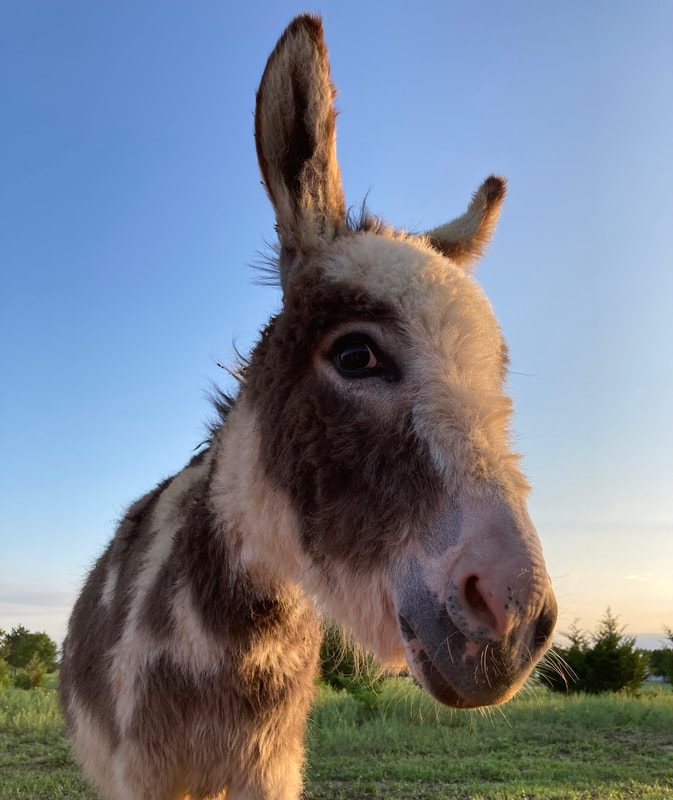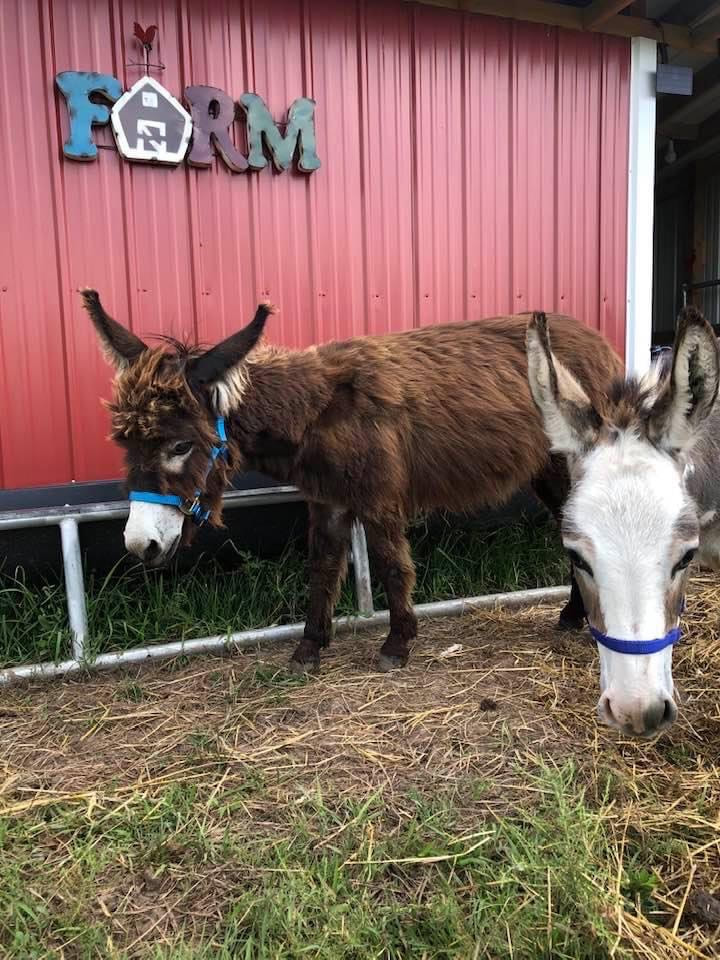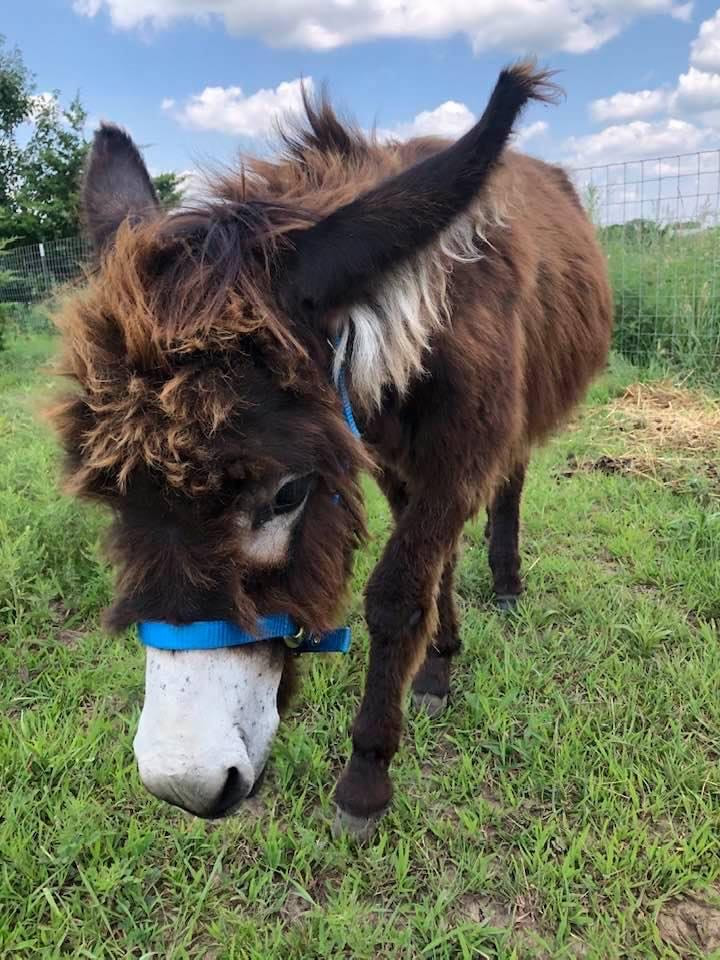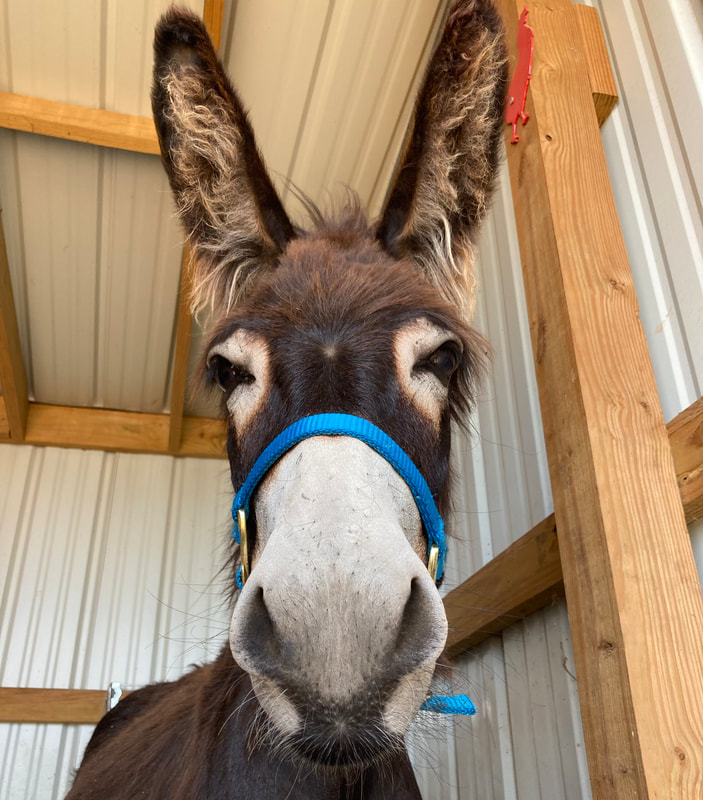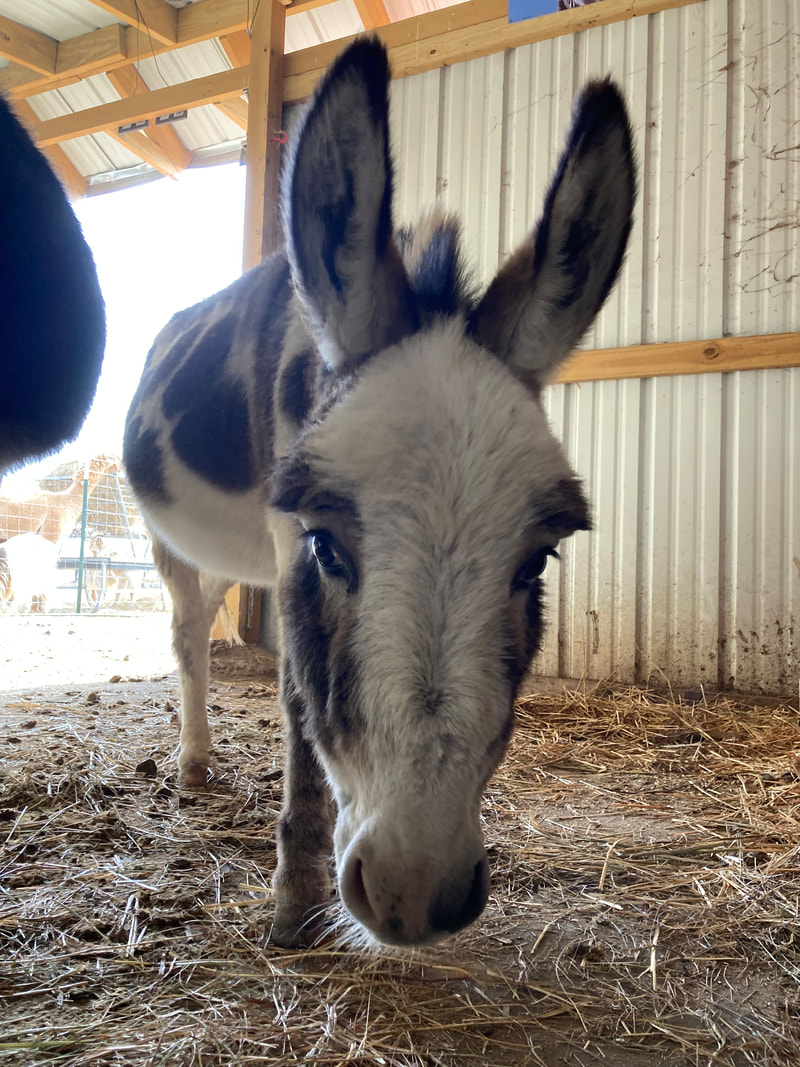MINIATURE MEDITERRANEAN DONKEYS
Physical Description
Donkeys differ from horses in shape and are characterized by their large head, long ears and cow-like tail. They have an erect mane and lack the forelock (bangs) and prominent withers (the highest part of the back at the base of the neck) of a horse. The hair ranges from flat, to curly, to long and shaggy, and in texture from smooth to wiry. The hair coat is shed out much later in the summer than that of the horse and serves to protect the donkey from the weather and flies.
Donkeys' eyes are at the sides of their heads, giving them a wide field of vision. They have both monocular and binocular vision, which allows them to see two fields of vision at once (monocular) or to focus on the same thing with both eyes at the same time (binocular). There is a blind spot directly in front of the donkey and one directly behind.
Their hearing is acute and the ears can move independently to locate the source or general direction of sounds. A donkey's long ears have an excellent blood supply, which is a desert adaptation for cooling the body.
There is not much known about donkeys' sense of smell. However, it is generally agreed that it is somewhat well developed. Donkeys use their sense of smell to determine if something is life-threatening or friendly, to locate food, and to identify each other, as well as to identify humans.
They have a well-developed sense of touch. Consequently, touch is the donkey's most important sense for responding to cues of their handler. The most sensitive areas are around the eyes, ears and nose. Other sensitive areas to touch are the withers, ribs, flanks and legs.
Size
Unlike many other miniature breeds (such as toy poodles), the miniature donkey is not a bred-down version of a larger donkey. Their small size is natural. Miniature donkeys are not more than 36 inches (91 centimeters) tall, measured from the highest point of the withers to the ground. Miniatures weigh 200 to 450 pounds (91 to 204 kilograms). For comparison, standard donkeys range from 36 to 48 inches (92 to 123 centimeters) tall and weigh 400 to 500 pounds (181 to 227 kilograms).
Native Habitat
Miniature donkeys are native to the Mediterranean islands of Sicily and Sardinia and were first imported into the United States in 1929 by Robert Green. He bought six jennets and one jack. Of those, three jennets and the jack survived to produce the first miniature donkeys born in America. The current U.S. population is estimated to be from 10,000 to 20,000. Today, imports of miniature donkeys are difficult as they are reported to be near extinction in their native area. Miniature donkeys are very popular as companion animals and for show.
Communication
Donkeys communicate by braying, a sound also known as a "hee-haw." Each donkey has its own style of braying, which can range from barely being audible to a "thunderous bray."
Food/Eating Habits
Donkeys are grazing herbivores with large, flat-surfaced teeth adapted for tearing and chewing plant matter. Like many other grazing animals, they grasp the plant first with their muscular lips, pull it into their mouth and then tear it off with their teeth. Donkeys do not ruminate like cattle, but use hindgut fermentation to digest their food.
Donkeys are considered "easy keepers," meaning they utilize their feed very efficiently and can survive on good quality hay alone. Because of this, owners must be careful that they do not overfeed their donkeys. Fat donkeys will develop a "crest," or fat roll, on their necks that will be there for life once it develops.
Miniature donkeys require good quality hay and fresh, clean water. Their primary food is grass, but they also graze other shrubs and desert plants. If only poor quality hay is available, it should be supplemented with a commercial feed. Because donkeys are prone to weight gain, their feed should be closely monitored. At the Kids' Farm, donkeys receive mixed grass hay and herbivore feed twice daily.
Social Structure
The major attraction to miniature donkeys, for humans, is their docile personalities. They form close attachments to their owners and to other donkeys. Donkeys are herd animals and do not respond well to isolation. Because of their laid-back personalities, they make wonderful pets and companions for children, people with disabilities, and elderly people.
Donkeys are very observant and cautious animals. They will refuse to do anything that appears threatening. This behavior has earned the donkey its reputation for being stubborn. When a donkey is startled by something, it usually will not run blindly in fear. Its natural instinct is to freeze or run a few steps and then look to see what the threat was. Domestic donkeys interact well with other livestock animals such as horses, cows, goats, sheep and alpacas. Donkeys are used as companions for weaned foals and for nervous, injured or recovering animals.
Reproduction and Development
Jennets (females) can become fertile at one year of age, but should not be bred until they are 2.5 to 3 years, depending on their overall physical maturity. They have heat cycles every 18 to 21 days throughout most of the year. Miniature donkeys, on average, carry a foal for 12 months. The average jennet produces one offspring every 13 to 14 months. Birth weights are generally between 18 and 25 pounds (8.2 to 11 kg). Twinning in miniature donkeys is rare. Foals are up and nursing within 30 minutes and are weaned at 5 to 6 months of age. Jacks (males) can be fertile at 1 year of age.
Lifespan
With lifelong proper care, donkeys can live well into their 30s with the average life span being 33 years. Jennets can produce foals into their early 20s. The average life span of a wild donkey is 25 to 30 years.
Donkeys differ from horses in shape and are characterized by their large head, long ears and cow-like tail. They have an erect mane and lack the forelock (bangs) and prominent withers (the highest part of the back at the base of the neck) of a horse. The hair ranges from flat, to curly, to long and shaggy, and in texture from smooth to wiry. The hair coat is shed out much later in the summer than that of the horse and serves to protect the donkey from the weather and flies.
Donkeys' eyes are at the sides of their heads, giving them a wide field of vision. They have both monocular and binocular vision, which allows them to see two fields of vision at once (monocular) or to focus on the same thing with both eyes at the same time (binocular). There is a blind spot directly in front of the donkey and one directly behind.
Their hearing is acute and the ears can move independently to locate the source or general direction of sounds. A donkey's long ears have an excellent blood supply, which is a desert adaptation for cooling the body.
There is not much known about donkeys' sense of smell. However, it is generally agreed that it is somewhat well developed. Donkeys use their sense of smell to determine if something is life-threatening or friendly, to locate food, and to identify each other, as well as to identify humans.
They have a well-developed sense of touch. Consequently, touch is the donkey's most important sense for responding to cues of their handler. The most sensitive areas are around the eyes, ears and nose. Other sensitive areas to touch are the withers, ribs, flanks and legs.
Size
Unlike many other miniature breeds (such as toy poodles), the miniature donkey is not a bred-down version of a larger donkey. Their small size is natural. Miniature donkeys are not more than 36 inches (91 centimeters) tall, measured from the highest point of the withers to the ground. Miniatures weigh 200 to 450 pounds (91 to 204 kilograms). For comparison, standard donkeys range from 36 to 48 inches (92 to 123 centimeters) tall and weigh 400 to 500 pounds (181 to 227 kilograms).
Native Habitat
Miniature donkeys are native to the Mediterranean islands of Sicily and Sardinia and were first imported into the United States in 1929 by Robert Green. He bought six jennets and one jack. Of those, three jennets and the jack survived to produce the first miniature donkeys born in America. The current U.S. population is estimated to be from 10,000 to 20,000. Today, imports of miniature donkeys are difficult as they are reported to be near extinction in their native area. Miniature donkeys are very popular as companion animals and for show.
Communication
Donkeys communicate by braying, a sound also known as a "hee-haw." Each donkey has its own style of braying, which can range from barely being audible to a "thunderous bray."
Food/Eating Habits
Donkeys are grazing herbivores with large, flat-surfaced teeth adapted for tearing and chewing plant matter. Like many other grazing animals, they grasp the plant first with their muscular lips, pull it into their mouth and then tear it off with their teeth. Donkeys do not ruminate like cattle, but use hindgut fermentation to digest their food.
Donkeys are considered "easy keepers," meaning they utilize their feed very efficiently and can survive on good quality hay alone. Because of this, owners must be careful that they do not overfeed their donkeys. Fat donkeys will develop a "crest," or fat roll, on their necks that will be there for life once it develops.
Miniature donkeys require good quality hay and fresh, clean water. Their primary food is grass, but they also graze other shrubs and desert plants. If only poor quality hay is available, it should be supplemented with a commercial feed. Because donkeys are prone to weight gain, their feed should be closely monitored. At the Kids' Farm, donkeys receive mixed grass hay and herbivore feed twice daily.
Social Structure
The major attraction to miniature donkeys, for humans, is their docile personalities. They form close attachments to their owners and to other donkeys. Donkeys are herd animals and do not respond well to isolation. Because of their laid-back personalities, they make wonderful pets and companions for children, people with disabilities, and elderly people.
Donkeys are very observant and cautious animals. They will refuse to do anything that appears threatening. This behavior has earned the donkey its reputation for being stubborn. When a donkey is startled by something, it usually will not run blindly in fear. Its natural instinct is to freeze or run a few steps and then look to see what the threat was. Domestic donkeys interact well with other livestock animals such as horses, cows, goats, sheep and alpacas. Donkeys are used as companions for weaned foals and for nervous, injured or recovering animals.
Reproduction and Development
Jennets (females) can become fertile at one year of age, but should not be bred until they are 2.5 to 3 years, depending on their overall physical maturity. They have heat cycles every 18 to 21 days throughout most of the year. Miniature donkeys, on average, carry a foal for 12 months. The average jennet produces one offspring every 13 to 14 months. Birth weights are generally between 18 and 25 pounds (8.2 to 11 kg). Twinning in miniature donkeys is rare. Foals are up and nursing within 30 minutes and are weaned at 5 to 6 months of age. Jacks (males) can be fertile at 1 year of age.
Lifespan
With lifelong proper care, donkeys can live well into their 30s with the average life span being 33 years. Jennets can produce foals into their early 20s. The average life span of a wild donkey is 25 to 30 years.


